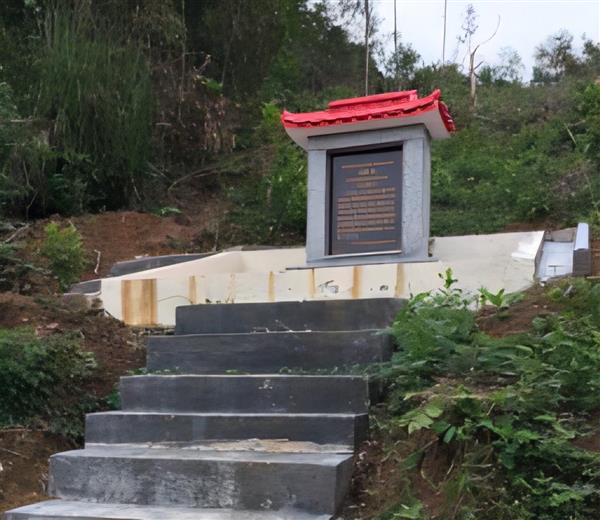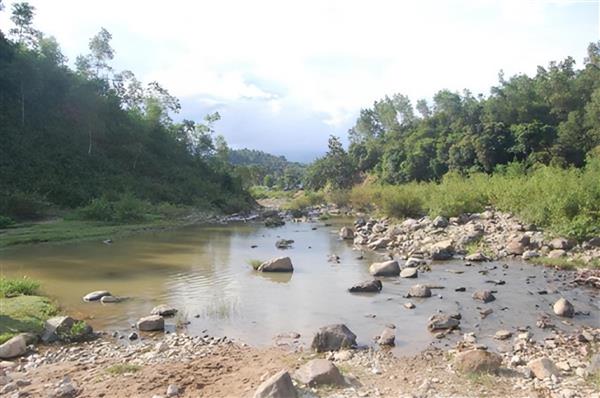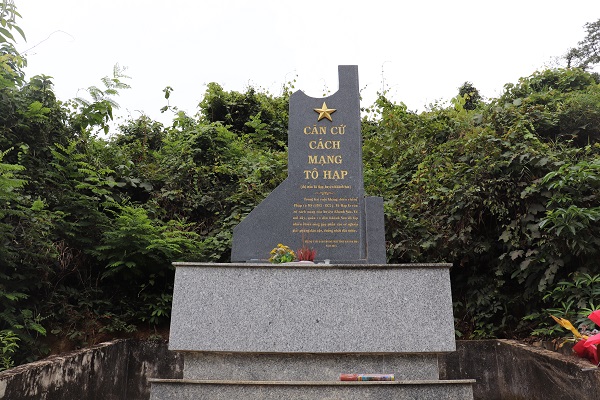Description
The To Hap Revolutionary Base is located along the To Hap River basin, in two communes Ba Cuong, Son Binh and To Hap town, Khanh Son district, Khanh Hoa province. In addition to the above name, the monument is often called To Hap Valley or Death Valley by locals.
The name To Hap was born to measure the river basin flowing through Khanh Son district, there are many To Hap trees, which are latex trees used as medicinal herbs, so the local people named the tree species To Hap. To Hap is a valley surrounded by main mountain ranges such as Da Bia (YaBi) and Shoung Khong, YaBio... During the resistance war against the US imperialists, To Hap was chosen as a revolutionary base and a centralized headquarters. many large agencies of Khanh Hoa Provincial Party Committee, armed forces of zone 5 and Khanh Hoa province.
With a convenient location, located on the important communication axis of Inter-Area V and Central, the gateway to the plateau. On the other hand, To Hap revolutionary base was also an important position for the Vietnamese revolution, because it was located opposite Cam Ranh military base - at that time the largest military base. of the United States in Vietnam. With that in mind, the three Inter-provinces (Binh Thuan, Ninh Thuan, Khanh Hoa), Inter-region V and Khanh Hoa province chose Khanh Son area to build into a complete Revolutionary base, as a support for expansion. revolutionary movement and anti-US - Wei springboard in the South Central region.
The main clusters of relics forming the revolutionary base are distributed in the following areas:
- Suoi Gia area, Ba Cuong commune today;
- To Hap area, To Hap town today;
- The area of Co hamlet, Son Binh commune today.
1. Grass Hamlet Area:
Now belongs to hamlet 2, Son Binh commune, Khanh Son district. This is the most important area of the relic, is the headquarters, gathers many big agencies of Khanh Hoa Provincial Party Committee, armed forces of Zone V and Khanh Hoa province such as Battalion 120, Company 254… and was the directing agency of Zone VI from 1959 to 1963. The terrain of this area is rugged with many high peaks surrounding it such as Cha A and Gia Ngeo mountains in the south, Doc Gao and Cha Pa mountains in the south. In the east and north there are some hills covering.

 The stele of the revolutionary historical relic Xom Co, Son Binh commune, Khanh Son district
The stele of the revolutionary historical relic Xom Co, Son Binh commune, Khanh Son district
2. Suoi Gia area, Ba Cuong commune:
This is the headquarters of the Khanh Son District Party Committee from 1960 to 1962, after moving from Son Trung commune. The location of the District Party Committee's offices is located on the eastern side of Hon Gam, including the following committees: Kinh Tai, District Party Committee, District Team... bordering Gia Phung Mountain, and Dua Stream in the North. At the foot of Gia Phung mountain in the south and at the foot of Hon Gam, there are a number of small streams such as A Thi stream, Gia stream, which is the area where many major events of Khanh Hoa province and Khanh Son district took place during the years of fighting against the US to save the country. such as: 1955 Khanh Son District Party Committee held a conference to thoroughly grasp and discuss measures to implement the Resolutions of the Central Committee and the Provincial Party Committee; In 1957, Khanh Hoa Provincial Party Committee held a conference to expand the province to assess the situation in the new period...

Suoi Gia area, Ba Cuong commune
In 1963, due to the strong sweep of the US - Wei, in order to ensure safety, secrecy and actively fight the raid, the agencies of Khanh Son district moved to To Hap and used this as their headquarters until the time of the invasion. The war of resistance against the US to save the country was won.
3. To Hap area:
This is the most important area, concentrating many agencies and armed forces of Khanh Son district from the 1960s until the victory of the resistance war against the US to save the country.
After moving from Gia - Ba Cuong stream to To Hap area, the agencies and resistance forces of Khanh Son district chose To Hap stream basin as a place to station their troops. Around this area, there are many large mountain peaks such as Doc Gao, La Bin in the North; Hon Gam, Hon Ham in the East; Gia Uy, Da Trao in the West; Lo Hang in the south… This area has many streams, which are ideal conditions for agencies and armed forces to operate and fight the enemy's raids.
Ham Mountain[1] is the communication line between Inter-Region V and Central; In 1952, Comrade Le Duan on his way to the North to work also stopped here.
Since the leadership units and agencies of the Third Inter-province, Khanh Hoa province, Khanh Son district, etc., chose To Hap valley as a revolutionary base, it has made political, economic and social life of the local people Khanh Son ethnic group changed. Under the leadership of the Party, which is directly the Third Inter-provincial Party Committee, the Khanh Hoa Provincial Party Committee directed the patriotic movement of ethnic minorities in Khanh Son district to develop strongly, making a small contribution to the overall victory. of the nation. Continually defeat the enemy's plots and tricks for the mountains, from the policy of "Conquer the Upper Mountains" to organize gum drives, establish "Strategic Hamlets" in "Special War" to the policy of destruction. our revolutionary base with all their most modern forces and means of war.
The enemy was looking for all sorts of plots to corner the people of Son Phong and Mien I, with the focus being on Ba Cluster. To Hap - where they called "To Hap Secret Zone" had the foundation and the earliest and most solid revolutionary movement, supporting the direction of the District and the three Inter-provinces (Khanh Hoa, Ninh Thuan, Binh Thuan).
By the end of 1959, the enemy had to bitterly admit that they had fundamentally failed in the policy of "To add and destroy the communists" in Khanh Son. When talking about the cause of failure, they blamed geographical factors, unfavorable population distribution, not to mention the basic factor which is the determination to follow the Party to the end of the vast majority of Khanh Son people. The enemy worriedly commented that "In particular, the To Hap Upland area (Cam Lam) with a population of over 3000 people living separately, too far from the plain may become a fighting area for the Viet Cong in the future"[2].
In 1963, at the end of the anti-coup campaign, we destroyed 200 enemy names and the so-called "Operation Thiem First" of the enemy was defeated miserably, the objective of the campaign was completely unrealized. To Hap valley has entered the history of Khanh Son and Khanh Hoa as a miraculous culmination of bravery and people's war art, and at the same time as the "Valley of Death" for the enemy[3]. The victory over the "Operation Thiem First" of Khanh Son's army and people is a milestone marking the bankruptcy of the "Special War" strategy of the US imperialists for Khanh Son in particular and the West of Khanh Hoa in general. .
It can be said that the role and effect of the To Hap Revolutionary Base on the cause of the resistance war against the US to save the country of the province, the region in general and the districts of Khanh Son and Cam Ranh in particular is very great. Khanh Son was the cradle of the revolution, a place to hide and nurture cadres and soldiers, the focal point for the direction of the Inter-province, Zone VI and Khanh Hoa Provincial Party Committee during the early years of the resistance war against the US for national salvation. Khanh Son is also a leading district in self-liberation and self-liberation, re-forming the three-regional position, building an increasingly strong base, serving as the initial base for soldiers and cadres of the Inter-province, Zone VI and Khanh Hoa Province to open rural, delta and urban movements. For Cam Ranh, the birth and steady existence of the To Hap - Khanh Son base right next to the US military base, despite the destructive attack of the enemy, was a summoning flag, the great cheers. Thanks to the people, the land and the resilient spirit of the Party Committee and the government of Khanh Son district, the Party Committee, officials and soldiers of Cam Ranh district, the armed forces of the region and the province … has completed its mission, contributing to the victory in the resistance war against the US to save the country and unify the country.
The peculiarity of this type of monument is that it is outdoor, located in the mountainous area with a large area, the distribution of the main relic clusters is scattered. old is almost gone. Over time, trees have grown to cover or because people have cleared the fields for farming, making the relic lost its trace. Currently, there are only a few caves, located deep in the forest. In 1999, Khanh Hoa Monuments and Scenic Landscape Management Center erected steles in three areas to introduce the relic.
In 2008, the To Hap revolutionary base was ranked by the People's Committee of Khanh Hoa province No. 2855/UB-QD dated November 18, 2008 as a provincial-level historical and cultural relic.

To Hap revolutionary base beer
[1] This name was given by revolutionary cadres because there were many caves around the mountain, which were favorable conditions for the revolutionary armed forces to shelter against bombs and bullets of the US - Wei.
[2] Report dated 16/12/1958 (the copy is kept at the Party History Research Department of the Propaganda Department of Khanh Hoa Provincial Party Committee).
[3] The name Ton That Dinh and soldiers participating in the raid and the enemy press after the Thiem first campaign called To Hap valley "Valley of death".